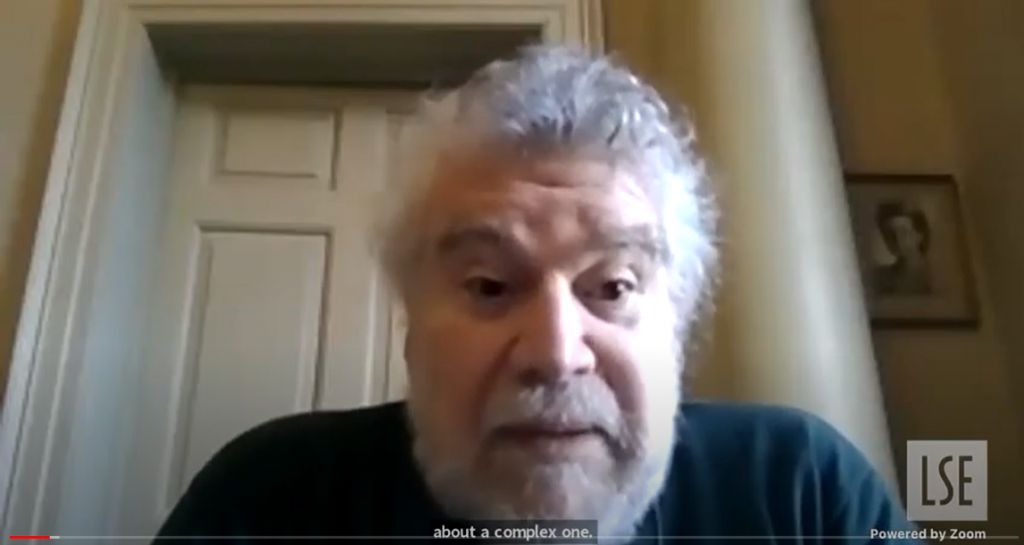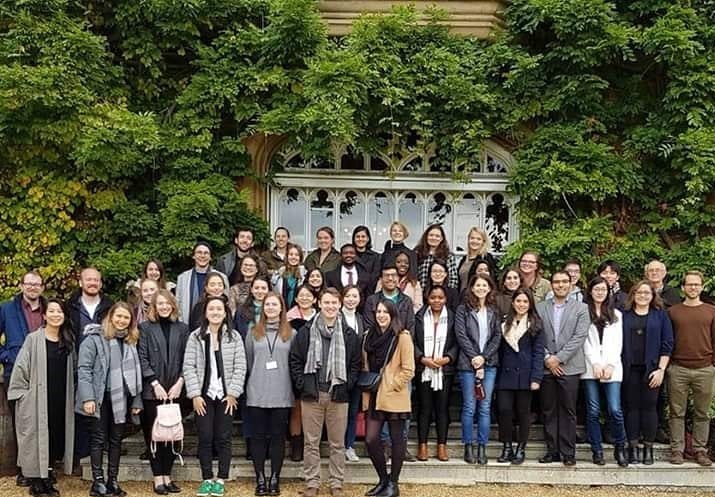On Friday 15 October, Gabriel Palma gave an online lecture on ‘Why the Rich Stay Rich (no matter what)’ as part of the Cutting Edge Issues in Development Lecture Series for 2021/22. Professor Branko Milanovic was an invited discussant for the lecture. José Gabriel Palma is a Chilean economist; he has taught at the Faculty of Economics at the University of Cambridge since 1981 (now emeritus). He is also a professor of Economics at the University of Santiago (part-time). Read what MSc students Luisa Fernanda Barajas García and Blaire Ng took away from the lecture below.
You can watch the lecture back on YouTube or listen to the podcast.

Explaining why certain countries have reached certain levels of economic and social development, while others have been left behind and stuck in poverty traps, has been one of the main topics of interest for development studies thinkers. Along these lines, the Latin American region seems to be the standard-bearer of inefficient institutions and markets, as well as high levels of inequality that are consistent over time. However, Gabriel Palma’s proposal invites a shift from understanding inequality as a question of how much economic output we generate, to a more detailed understanding of how the output is distributed. It is in this shift how we can explain such a latent division between developed (rich) and developing (poor) countries.
Gabriel Palma begins his presentation by describing two ways of understanding inequality: as disposable income inequality or as market inequality. The difference between the two is that the former measures levels of inequality after taxes and transfers (net income), while the latter focuses on the immediate outcomes of economic activities (income before any deductions). Each of these perspectives, seeing them as complementary to each other, allows us to identify the reasons behind the huge diversity in inequality levels.
In this regard, Gabriel Palma presents 8 key considerations (referred to as stylised facts) about how income is distributed across countries and how income is distributed among the population. These are presented below:
- Stylised fact No. 1: Inequality is highly unequal among countries when you organised them according to their Gini coefficient.
- Stylised fact No. 2: Inequality is particularly disparate among middle-income countries, with some increasing diversity among high-income countries when you organised them according to their GDP per capita.
- Stylised fact No. 3: The broad spectrum of different levels of inequality between countries suddenly changes when we pay attention to each country’s population.
- Stylised fact No.4: If we divide the country’s population into two halves: the middle and upper-middle, we find that both halves of the population tend to get a similar income share compared to other countries in the world, but they divide it among their own constituents very different.
- Stylised fact No.5: In some countries, inequality becomes extreme because the upper-middle extracts 10% more of income from the other half (what he categorizes as D10+), and in some cases doubles it (D10++).
- Stylised fact No.6: There is increased market inequality among OECD countries (high-income countries).
- Stylised fact No.7: There is little to show for increased market inequality among OECD countries.
- Stylised fact 8: For unequal middle-income countries there are two very different routes to improve inequality: redistribution of wealth policies or improvement of the economic performance.
However, what is interesting about Gabriel Palma’s study is that it offers a third explanation for the causes of inequality between and within countries. Traditionally, economic development and growth have been understood from two disciplines: the neoclassical, where inequality is the result of factors internal to countries (social mobility, education, health, income per capita, natural resources, sophisticated technologies), and the post-Keynesian or structuralist tradition, where politics, history and institutions matter just as much as economic fundamentals. The author’s central argument is that inequality is the product of a conflict between a multiplicity of actors, with multiple interests, whose interaction leads to different levels of inequality as they distort market outcomes to their own advantage.
Essentially, Gabriel Palma argues that perfect marker equilibriums, where price rules and rule-makers function harmoniously – or at least coherently – are not so straightforward. This ideal scenario does not take into account the presence of powerful agents (within the political or private sphere) who have the power to distort the market by capturing for themselves 10% of the pie, or even double of it. This inevitably leads a society to experience not only more inefficient markets but also ridiculous levels of inequality. In this sense, inequality in countries also becomes a problem of governance and domination by elites who remain in power and capture rents over time.
Although the author mentions two alternative solutions to this situation in his latest stylised fact, the truth is that there is still no magic formula to solve inequality. While his explanation provides a valuable contribution to the study of development, it still leaves us to argue about the best way to tackle it. And it is at this point we return to the endless questions surrounding the role of markets, states, of civil society, the effectiveness of indicators and their limitations in scope and measurement to tackle barriers to development and welfare.
Luisa Fernanda Barajas García
_______________
When COVID-19 brought the first wave of global lockdowns last year, Amartya Sen wrote that it was possible to build a better, more equal post-pandemic world. Yet 1.5 years onwards global inequality has only worsened as we had feared, with an unprecedented increase in wealth of the richest thanks to the stock market rally. Decades of progress made on inequality as a result of economic development in some poor countries have been reversed. Dr Gabriel Palma’s lecture on ‘Why the rich stay rich (no matter what)’ is thus truly timely and thought-provoking.
Palma explained in detail his innovative approach to examine and measure inequality, and described several observations on disposable income inequality:
- Inequality is highly diverse across countries, increasingly so in the middle-income and high-income countries.
- Such diversity is mainly related to income distribution between the top 10% (D10) and bottom 40% (D1-D4), i.e. the patterns of the top 10% extracting wealth from the bottom 40% (Palma ratio compares D10 to D1-D4). The middle group’s share of the pie (D5-D9) is relatively homogeneous.
- Extreme inequality arises because the top 10% not only extract their wealth from the bottom 40% but also the middle and upper-middle classes (I.e. D5-D9 becomes <50% – see Figure 8, a truly obscene chart).
To put it simply, quoting Professor Branko Milanović, inequality becomes ‘the struggle between the top versus the bottom’, and extreme inequality is one ‘between the top versus the middle’.
So how did the rich get here? Palma argued that such diverse inequality is related as much (if not more) to history, politics and institutions as to economic fundamentals. Powerful, rich agents in this ‘antagonistic’ conflict can distort market outcomes to their own advantage. Dysfunctional institutions can persist - which is how the rich oligarchies have managed to ‘rig the system’ and continue extracting rents.
Gabriel Palma then discussed how market inequality has increased fiercely among the OECD countries particularly since the neoliberal reforms, such that there is no longer much difference among the European and Latin American countries. How to improve this inequality? He indicated two ways, of a very different nature. While Germany reduced market inequality via pharaonic redistribution and social protection that are increasingly inefficient and unsustainable in the long run, South Korea and Taiwan got there already in the sphere of production without much redistribution. He particularly warns against seeing ‘the German route’ as the exclusive way to address market inequality since ‘social protection’ has started to benefit the rich instead nowadays, via bank bailouts and QE in the financial markets.
In order to take ‘the Korean route’, Palma argued for more balanced productivity and employment growth across all different economic sectors. Branko Milanović also suggested work on getting more equal market income by deconcentrating ownership or wealth or reducing inequality in wages.
However, these changes will take time and are not easy to implement as established interests would get in the way. Moreover, policymakers seem to have become more sensitive to financial market expectations (which are increasingly bets and speculations from ‘armchair rentiers and traders’), as seen from the timing and patterns of interest rate and ‘unlimited QE’ (quantitative easing) policy changes in recent times. Are we ready to challenge our over-financialised economy? In my view, to take a ‘more Korean, less German’ route, a fundamental rethink on how to best run our economy and society is needed. This has become more pressing as populist parties which claim to promote a more equal society have gathered more dissatisfied voters in recent years. It could give way to more authoritarian practices that are contrary to liberal democratic values.
Now some of us might become slightly puzzled – wasn’t Parasite in Dr Ha-Joon Chang’s lecture last week all about the deteriorating inequality in South Korea? Did Gabriel Palma’s positive depiction of Korea play down the seriousness of its inequality? To begin with, Palma’s chart did show that its inequality has been rising, although still ‘low’ on a global scale. Also, if we look back to the discussion between Ha-Joon Chang and Professor Francisco Ferreira last week, two important points can shed light on this purported contradiction:
- Firstly, the Gini coefficient is a relative measure, that can’t fully capture the absolute change in income inequality lived by the people.
- Secondly, the kind of inequality in Korea was also somewhat related to people’s collective perception of the existence of a ‘just world’ and ‘meritocracy’ and societal expectations of the future, all of which need to be examined against Korea’s recent history. Although the Palma ratio has partly addressed Gini’s shortcomings, both can’t tell stories like this.
In this sense, countries’ internal social and cultural dynamics should also be considered when analysing inequality. This is probably why the logical next step of the research, as Branko Milanović and Gabriel Palma both agreed, is to look at who is living behind the deciles (D1-D4, D5-D9, d10, d10+, d10++), who are they sociologically and politically, in order to understand the background of the struggle between the poor, middle class, rich and the superrich.
Inequality can be an emotive topic, arousing feelings of unfairness in the world that don’t stay well with our sense of justice and self-worth. Telling stories behind these numbers not only informs our debates but also reminds us about a more sincere effort to improve inequality and our society.
For details of Gabriel Palma’s analysis, please refer to:
Palma, J. G. Behind the Seven Veils of Inequality. What if it’s all about the Struggle within just One Half of the Population over just One Half of the National Income?, Development and Change vol 50(5) (2019) pp. 1133-1213. https://onlinelibrary.wiley.com/doi/10.1111/dech.12505
Palma, J. G. (2020). Why the Rich Stay Rich. On dysfunctional institutions’ “ability to persist” (no matter what). https://doi.org/10.17863/CAM.62839
Blaire Ng
_______________
The next guest lecture will be with Clare Short on Friday 22 October 2021 on ‘What’s wrong with Aid?’. LSE Students, Staff and Alumni can register here. External audiences can join the lecture via YouTube.
The views expressed in this post are those of the author and in no way reflect those of the International Development LSE blog or the London School of Economics and Political Science.





